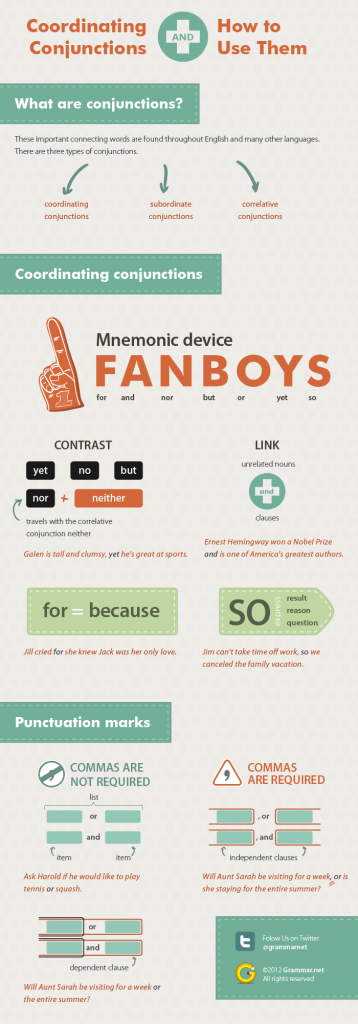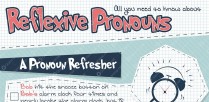What are conjunctions? These important connecting words are found throughout English and many other languages. There are three types of conjunctions. They include coordinating conjunctions, subordinate conjunctions and correlative conjunctions. Coordinating conjunctions are small, effective words that join independent clauses, dependent clauses, phrases, things and items in lists. By definition, conjunctions join two separate things, and they create transitions between different thoughts.
In English, there are seven coordinating conjunctions. They are for, and, nor, but, or, yet and so. They are also known by the mnemonic device FANBOYS. These seven coordinators follow similar punctuation rules, but they are used differently in sentences.
To download high-resolution poster click here
Embed this image to your site:
Nor, or, yet and but all express contrast. The word “and” links unrelated nouns and clauses. So is used to express a result, a reason or to introduce a question.
For is frequently used like a preposition, but it can also be used like a conjunction that is similar to the word because. Here is an example.
Jill cried for she knew Jack was her only love.
Yet is a versatile conjunction that expresses contrast. Here’s an example.
Galen is tall and clumsy, yet he’s great at sports.
Nor is a unique negative coordinator that often travels with the correlative conjunction neither, but it can also work with no, never and other negative words. Here’s an example.
He is neither smart nor sane.
Because coordinators are so versatile, it’s important to know how to apply appropriate punctuation marks. Coordinators like “or” and “and” can separate items in lists. In these cases, commas are not required. Here are two examples.
Ask Harold if he would like to play tennis or squash.
Cookies and milk go together like peanut butter and jelly.
As a general rule, commas are required before coordinators if they separate independent clauses. Here are a few examples.
Will Aunt Sarah be visiting for a week, or is she staying for the entire summer?
Ernest Hemingway won a Nobel Prize, and he is one of America’s greatest authors.
Jim can’t take time off work, so we canceled the family vacation.
When coordinators link an independent clause and a dependent clause, no comma is required. Here are a few examples.
Will Aunt Sarah be visiting for a week or the entire summer?
Ernest Hemingway won a Nobel Prize and is one of America’s greatest authors.
The flood destroyed many items in the basement but not everything.
Children create secret languages so that adults won’t understand them.
Coordinators are indispensable when linking items and clauses. They create contrast and smooth transitions while linking related or unrelated thoughts. These tiny words are versatile writing tools that can be used in innumerable ways. They perform a vital function in linking items, and they are found in many common phrases. If you’ve been experimenting with these coordinators or have trouble deciding which conjunction to use, feel free to share your comments.



![12 idioms about time, better later than never [infographic]](https://www.grammar.net/wp-content/uploads/2012/05/12-idioms-about-time_small-308x95.png)
![10 Idioms about Home [infographic]](https://www.grammar.net/wp-content/uploads/2012/05/10-idioms-about-home_small-308x95.png)



